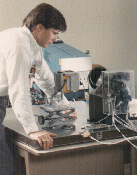|

Meet Mars Man Mehall



by Tricia Dieck, ASU College of Education
and Arizona Mars K-12 Education Program

With the Mars Global Surveyor Thermal Emission Spectrometer (TES)
on its way to Mars, you would think that Greg Mehall could relax. This
is not so! Greg is the mission engineer for TES. If you've been
keeping up with TES News, then you've noticed that he is the one
who writes the TES updates that appear in each issue! Greg is responsible
for making sure that the TES is working properly, now and throughout
the entire MGS mission.
FIGURE (at top of article): Greg Mehall working with TES engineering
model back in 1990. Part of SBRC Photo 90-1-144, courtesy Santa Barbara
Remote Sensing.
This phase of the MGS mission is actually a bit more calm for Greg.
He originally worked in Santa Barbara, CA, for the Santa Barbara Research
Center (now Santa Barbara Remote Sensing-- SBRS). While he was there, he
helped build the first TES instrument-- the one that flew on the ill-fated
Mars Observer. Before Mars Observer was launched in
September 1992, the TES principal investigator, Phil Christensen, hired
Greg away from Santa Barbara. He packed up his things and moved to
Phoenix. Working at Arizona State University, Greg began planning the
observations that Mars Observer TES would soon be making...
Mars Observer was lost in August 1993, just days before it was
to reach the Red Planet. After more than a year hiatus, work began on
the new TES for Mars Global Surveyor. Though still a resident
of Phoenix, Greg got on a plane and flew out to Santa Barbara to begin
working with the SBRS staff on the new instrument. Greg spent about
two and a half years commuting to Santa Barbara, spending only about
7 days a month in his new Phoenix home. Working many days and nights,
around the clock, paid off for Greg and the TES team when Mars
Global Surveyor lifted off from the Kennedy Space Center
on November 7, 1996. Since the launch, Greg has finally been able to
enjoy his Phoenix home and work in his ASU office again.
Greg first became interested in engineering when he was a kid during the
Apollo Moon missions. He pursued his interest in space exploration
by studying electrical engineering. He received a B.S. degree from the
University of Michigan and an M.S. from Stanford University. His main
interest was in optics, which led him to work on TES in Santa Barbara
after he finished school in the late 1980's.
From the time Greg was six years old, he enjoyed math and science. Because
of his early interest in space, Greg is very supportive of the
outreach efforts of the Arizona Mars K-12 Education Program. He has
volunteered his assistance at numerous workshops and enjoys telling
kids about the TES project. His patience, enthusiasm, and expertise
is evident when he explains the complexities of the MGS mission to
the variety of visitors and friends that visit our laboratory at
ASU.
Greg Mehall's involvement in space does not stop with TES. He has a
pilot's license and hopes to be selected to be an astronaut. Every
few years, NASA calls for astronaut applications, and Greg tries
every time. Maybe someday, Greg will be heading, "To Mars!"
Author Tricia Dieck has worked with the Arizona Mars K-12 Education
Program since August 195. She was the creator and first editor of
our K-8 newsletter,
Red Planet Connection.
She came to ASU
to obtain a Masters Degree in Science Education. As her May, 1997,
graduation date approaches, she is wrapping up a thesis about how
Red Planet Connection sparked student interest in science.
She will be moving to Minnesota and will be very much missed by
the TES group at ASU. -- K.S.E., editor
TES News is published quarterly by the Arizona Mars K-12 Education
Program. This newsletter may be copied for EDUCATIONAL PURPOSES ONLY.
EDITED BY Kenneth S. Edgett, Arizona Mars K-12 Education Program,
Arizona State University, Tempe, Arizona, USA.
|



